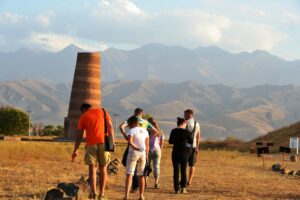Ak-Beshim, a settlement. Ak-Beshim is the remains of the medieval city of Suyab, which was the center of the Western Turkic Kaganate (V-VIII centuries). Hills and furrows at Ak-Beshim outline a large city. It is located 8 km south-west from Tokmok.
Suyab emerged in the V century as one of the easternmost settlements Sogdian merchants on the Silk Road. Ak-Beshim was once one of the most important cultural and trade centers in the Chui Valley, inhabited by Turks and Sogdians. Archaeologists attribute this city to the V-VI centuries. This date is based on the records of the Buddhist monk Tripitaka (602-644).
In 629 it was visited and described by Xuanzang. He noted the fertility of the soil, especially favorable for growing millet and grapes. At that time, Sogdian traders paid tribute to the Kagan of the Turks.
With the separation of the Western Turkic Kaganate, Suyab became its capital. In summer, the Khaganate retired to his headquarters in Navaket in the Talas valley. Türks ensured the safety of the state, and Sogdians ensured its economic well-being.
In 648-719. Suyab served as one of the westernmost fortresses of the Tang Empire. Thanks to the Chinese, Buddhism, which had previously coexisted with Nestorianism and Zoroastrianism, became the main religion.
The traces of the most ancient Christian monument on the territory of Kyrgyzstan – a small Nestorian church of VII-VIII centuries – were found in Suyab.
After 719 Suyab was given by the Chinese to the possession of allied Turgesh. During the Sino-Tibetan wars in the middle of the century the Tang garrison was stationed there again. After 766 it went to Karluks, who joined Uigur Kaganate.
The Chinese traveler Du Xuan who was passing through Suyab in the middle of VIII century found it in ruins. VIII century he found it in ruins though the Buddhist monastery was still functioning. After the Chinese retreat to the east in 787, there is little written news about the city. The treatise Hudud al-alam lists it as a city with a population of 20,000.
Suyab was finally abandoned due to the construction of Balasagun in the 11th century. The archaeological area of ancient Suyab covers 30 hectares. Excavations indicate the presence of numerous religious buildings, both Christian and Buddhist, in Suyab.
At the settlement of Ak-Beshim uncovered the remains of a castle VI-VII centuries, east of Shahristan – the ruins of a Christian temple VIII century (the cross-shaped interior with traces of paintings enclosed in a square pahsovoy walls) with an adjacent long yard and arched entrance aperture. Outside the city walls were two Buddhist temples where fragments of paintings, sculptures, works of arts and crafts were found. The Small Temple (VI- VII cc.) and the Great Temple (VII-VIII cc.) in Ak-Beshim with a deep portal, vestibule and guardhouse are also of great interest.
Ak-Buura river
Ak-Buura, river. It flows through the territory of Nookat and Karasuu rayons, Osh oblast. It



